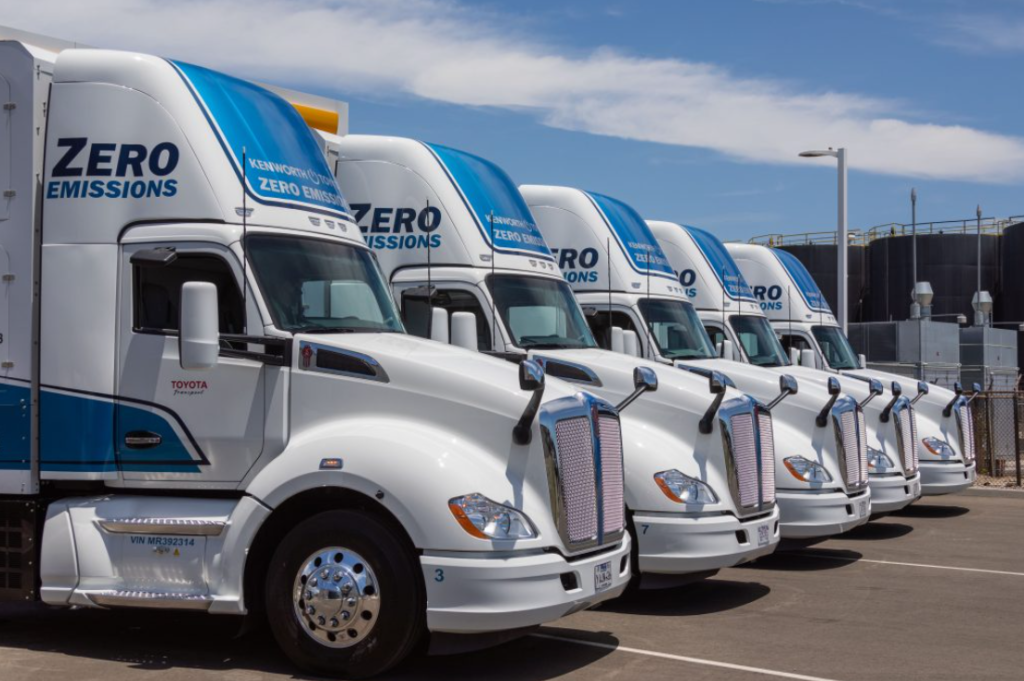By Joseph Webster and William Tobin
View the original article here

Long-haul trucking is a highly promising use case for the US hydrogen industry, and California and Texas are two large potential markets for pioneering hydrogen-fueled trucking. Both states have excellent green hydrogen potential and are taking initial steps to become hydrogen trucking hubs. When it comes to decarbonizing heavy-duty transportation, hydrogen is here for the long-haul.
Cleaning up hydrogen
Today, the vast majority of hydrogen is produced from reforming the methane in coal or natural gas in a process that produces ten times more carbon dioxide than hydrogen by mass. It is principally used for refining heavy sour oil and producing ammonia for fertilizer.
The most promising pathways to create zero-carbon clean hydrogen at scale are through renewables-produced green hydrogen or nuclear-powered pink hydrogen, both of which use zero-carbon electricity to separate hydrogen and oxygen via electrolysis. There is also blue hydrogen, which comes from natural gas in a process paired with carbon capture. Blue hydrogen’s role in decarbonization, however, is contingent on the mass buildout of carbon transportation and storage infrastructure.
If deployed judiciously, clean hydrogen can have a meaningful impact on lowering emissions in hard-to-electrify sectors, which require a chemical feedstock, long-duration energy storage, or extreme heat.
Long-haul trucking is a viable clean hydrogen offtaker
For most forms of transportation, growing economies of scale have given batteries an edge over hydrogen fuel cells. However, long-haul trucking—which accounts for 7 percent of transportation emissions—may be too high a fence for batteries to climb.
As a vehicle becomes heavier, its battery must expand proportionately in volume to provide the requisite power. Electric freight tractors use battery packs that are significantly heavier than the weight of diesel a truck typically carries, which decreases range and payload capacity while requiring more frequent charging. This is meaningful in the freight industry, where time is precious, and downtime can come at a cost of over $50 per hour before accounting for costs of charging. An electric long-haul truck takes thirty minutes to charge to only 70 percent capacity even with megawatt charging. In comparison, hydrogen re-fueling can be done quickly. Refueling a hydrogen truck takes ten minutes.
Hydrogen fuel cell trucks are therefore likely to edge out batteries for trips surpassing 180 miles and payloads above 24,000 pounds, according to an industry study.
The US Department of Energy estimates that total cost of ownership for hydrogen fuel cell long-haul vehicles will become affordable by 2030 thanks to new production tax credits for clean hydrogen. Furthermore, the department cites evidence that the long-haul trucking sector is willing to pay a premium for clean hydrogen. This outcome, however, is contingent on a buildout of refueling infrastructure along freight corridors. To boost demand, infrastructure could be built along freight lines that support high volumes of freight, such as near seaports. This can help medium-sized refueling stations reach their breakeven utilization rate. To do so, industry and policymakers must overcome a chicken-and-egg problem. The development of refueling infrastructure is critical to enable hydrogen-powered long-haul trucks, and—conversely—hydrogen refueling stations will rely on long-haul trucking for their income, as hydrogen uptake in transportation is likely to be confined to this sector.
California and Texas: Unlikely hydrogen trucking partners
California and Texas are important players in both green hydrogen and long-haul trucking.
Not only do the two states have the largest populations and economies in the country, but they also have outstanding green hydrogen potential.
Both California and Texas have excellent renewable resources, including solar and wind. The two states have deployed nearly 74 gigawatts of solar and wind capacity with another 36 GW in development.
Texas and California are the nation’s largest and second-largest renewables generators. As more renewable electricity production grows in these states, so will green hydrogen capacity—although there will be tensions between providing renewables for power generation or hydrogen.
Long-haul trucking is a natural use case for green hydrogen in both states. Texas and California are the country’s largest users of diesel for the transportation sector, consuming 633,000 barrels per day in 2021, or about 21 percent of total US diesel demand. Both states rely heavily on trucking to transport cargo from ports along the coast of California and Texas to destinations further inland. Indeed, Los Angeles, Long Beach, and Houston are the country’s first, second, and fifth-largest container ports by volume, respectively.
There is already evidence that Texas and California’s long-haul trucking sectors could see synergies between ports and green hydrogen production. California provides fiscal support for zero-emissions vehicles, plans to end the sale of fossil fuel-powered medium- and heavy-duty trucks by 2036, and continues to develop hydrogen refueling infrastructure. Tellingly, Hyundai Motor will soon operate thirty fuel cell electric trucks in California; Hyundai states this deployment will mark the largest commercial deployment of fuel cell electric trucks in the United States in the super-large vehicle class. In North Texas, Air Products and AES are teaming up to construct the country’s largest green hydrogen facility to service the trucking industry.
The trucking fleet is replaced very rapidly: the average lifespan of a super-large class truck is eight years, while the median truck on the road today is approximately six years old. In comparison, personal vehicles are replaced on average only every ten and a half years. Moreover, unlike the personal vehicle segment, most long-haul trucks are procured by fleet owners who pay very close attention to the total cost of ownership, not just the sticker price. If hydrogen-fuel trucks become more competitive than their diesel counterparts, there could be a relatively rapid adjustment.
Hydrogen: Here for the long-haul
Hydrogen’s technical and economic fundamentals are likely to improve as technology advances and the Inflation Reduction Act incentivizes investments in renewables. Owing to their renewables potential, large ports, and significant diesel demand, California and Texas are primed to lead the trucking market’s transformation. While trucking fleet turnover will take time, hydrogen appears poised to disrupt the US trucking market.
